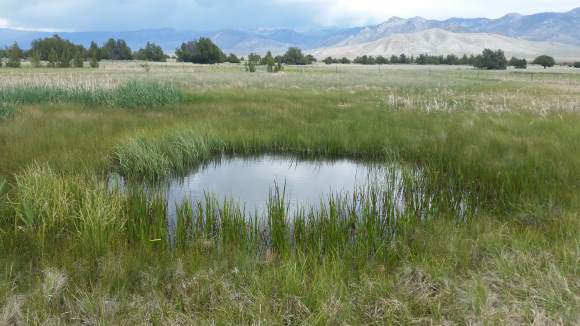
by Deep Green Resistance News Service | Jun 23, 2016 | Biodiversity & Habitat Destruction
By Will Falk / Deep Green Resistance
The Swamp Cedars in Spring Valley, Nevada have grown long memories. They stand on the valley floor under the bright Great Basin stars where the skies are still unspoiled by the encroaching glow of electricity. Beneath the trees’ branches, the blue petals of wild irises flutter in the breeze. All of them – the trees, the flowers, the stars – sway to the soft melodies played by the valley’s bubbling springs.
Most of the Swamp Cedars’ memories are pleasant. Carried by glaciers to the valley floor sometime in the last two and a half million years, the Swamp Cedars remember when wooly mammoths plodded through the Great Basin. The wind through their leaves whispers of a time when the Swamp Cedars trembled under the shadow of great teraton birds who rode the skies with their 25-foot wingspans. When wild horses stop at the springs to share a drink with the Swamp Cedars, the trees tell stories of the fleet native horses and camels that once ran the open spaces of North America.
Dawn in Spring Valley still carries the hint of curiosity the Swamp Cedars felt on that morning so many thousands of years ago when they watched the first humans walk from the foothills to rest in the welcome shade the trees offered. They learned to expect the humans regularly as they gathered under the trees for sacred ceremonies. They listened as the humans called themselves “Newe” and the trees learned that the word meant, “people.”
The Newe returned often to the Swamp Cedars for their ceremonies and the trees took delight with the Newe as old friends embraced after several seasons apart, as young people became lovers, and as information was shared about the year’s pinyon pine nut harvest.
A few of the memories are extremely painful. The Swamp Cedars recall when a different kind of human first arrived in Spring Valley. These humans were pale of skin and rode what the trees recognized as horses though they were a different species of horse than the native horses that had long since been lost. At first, there were just a few of the pale humans, but the trickle turned into a flood. The Swamp Cedars wince as they relive their first experience of steel – the excruciating pain that came when the first ax drove deep into living Swamp Cedar wood.
Worst of all, the Swamp Cedars witnessed the Newe screaming as the blue-clad humans on horses rode them down, the puffs of white smoke that turned into a haze, and the sharp cracks of rifle fire. The Swamp Cedars still recoil from the taste of blood in the soil when the bubbling springs turned red.
***
Dr. Ronald Lanner, one of the foremost experts on Great Basin trees explains the Swamp Cedars’ uniqueness: “…within the borders of Nevada, Rocky Mountain juniper is found in 39 mountain ranges but in only one valley – Spring Valley.” The Swamp Cedars carry an aura of magic. In fact, they are not cedars at all. They are actually Rocky Mountain junipers (juniperus scopulorum) and Rocky Mountain junipers always grow on dry, rocky mountain slopes or in somewhat shaded canyons. Always – except for the Swamp Cedars. Mysteriously, the Swamp Cedars grow in valley bottom woodlands that are flooded part of the year.
The Swamp Cedars of Spring Valley are likely on their way to evolving into a distinct species. Lanner describes, “…it is very likely the swamp cedars comprise a distinct ecotype of Rocky Mountain juniper. An ecotype is a genetically differentiated population that has evolved in adaptation to a distinctively different environment than characterizes that of the main population of its species.”
The Swamp Cedars are sacred to the Shoshone (Newe in their own language) peoples. According to Shoshone elder Delaine Spilsbury, Nevada’s Native peoples were hunter-gatherers who roamed the region in small familial groups while they searched for food. The Swamp Cedars were centrally located in the Shoshone’s traditional territories and offered ample shade during the hot Great Basin summers. Beneath the trees are a series of springs. Water from the springs encouraged plants and animals to proliferate. The Shoshone found many game birds and animals, medicinal plants, and fish in the nearby streams and ponds. Not far away from the Swamp Cedars, pinyon pine forests grew bounties of pine nuts. With these conditions, the Swamp Cedars became the favorite gathering place for the Shoshone and a sacred ceremonial site.
The Swamp Cedars are a massacre site. Three times over. Spilsbury explains that two of the massacres are of official military record while the last massacre happened at the hands of vigilantes with no military record.
The first two massacres happened in the 1860s. In the first massacre, most of the Shoshone escaped when American cavalry horses became mired in the mud created by the valley’s springs. The second massacre was much worse and Spilsbury says the written reports “state that men’s penises were cut off and shoved into their mouths and tree branches were shoved into women’s vaginas.”
The third massacre happened in 1897. This massacre is only remembered because two little girls hid in a ditch and were not discovered by the white vigilantes who murdered everyone else. The two little girls walked south to the Swallow Ranch. One of the two survivors was named Mamie by the Swallow family. Later, she married one of the Swallows’ hired hands – a Paiute man from Shivits, Utah named Joe Joseph. Spilsbury is the granddaughter of Mamie and Joe Joseph and, therefore, a direct descendant of a survivor of the last Swamp Cedar massacre.
The massacres cursed the Swamp Cedars with a bloody historical significance, but the massacres also endowed the trees with a deep, spiritual significance. According to Spilsbury, “Newe believe that because of their violent deaths, the spirits of the victims remain in the Sacred Trees.”
***
The Swamp Cedars are under attack. Close to 300 miles south of Spring Valley, the City of Las Vegas sprang up in the desert. Las Vegas’ population continues to grow in an arid landscape and the city is running out of water. Instead of restricting development, Sin City encourages residents and businesses to move to the city promising them access to the water they’ll need.

In 1991, the Southern Nevada Water Authority (SNWA) was created through a cooperative agreement among seven water and wastewater agencies in Southern Nevada including Big Bend Water District, City of Boulder City, City of Henderson, City of Las Vegas, City of North Las Vegas, Clark County Water Reclamation District, and the Las Vegas Valley Water District.
From the SNWA website: “SNWA officials are charged with managing the region’s water resources and providing for Las Vegas Valley residents’ and businesses’ present and future water needs.” To do this, SNWA has proposed a “Groundwater Development Project.”
The bulk of this plan hinges on a large pipeline from Las Vegas to rural eastern Nevada. The main pipeline is estimated to include 263 miles of buried water pipelines while an estimated 96 to 254 miles of collector pipelines will feed water to the main pipeline. The entire pipeline will pump 27 billion gallons of water from the desert annually. Between 71 and 88 wells will have to be dug in fragile ecosystems while somewhere between 96 and 254 miles of overhead distribution power lines will be built in a region famous for wildfires. The water will be taken primarily from 4 desert valleys – Spring, Cave, Dry Lake, and Delamar Valleys.
In other words, SNWA’s Groundwater Development Plan would destroy much of the Great Basin, would destroy Spring Valley and would destroy the Swamp Cedars.
According to Dr. David Charlet, in his study “Effects of Interbasin Water Transport on Ecosystems of Spring Valley, White Pine County, Nevada,” “Ecosystems of Spring Valley, like most valleys in Nevada, are stressed. Overgrazing, particularly during the late 1800s, water diversion, and groundwater pumping have weakened the plant communities.”
This means human activities are already undermining life in the area.
Charlet makes horrifying predictions for the Swamp Cedars, writing, “The groundwater development proposed by the SNWA for the Spring Valley will doom the populations of swamp cedars. It is unlikely that they will live long past the first 20 yr [sic] of drawdown…” In fact, Charlet believes the Swamp Cedars will act as the canaries in the coal mine as he describes what he thinks will happen, “The swamp cedars will be the first plant species in the valley to become locally extinct, and I imagine that they would not be able to hang on for more than 50 yr. The next species to follow the swamp cedars will be the greasewood, followed shortly by big Great Basin sagebrush, and finally by rabbitbrush.”
Dr. Lanner agrees with Dr. Charlet in Lanner’s study “The Effect of Groundwater Pumping Proposed by the Southern Nevada Water Authority on the ‘Swamp Cedar’ of Spring Valley, Nevada.” He writes, “Despite the fact that the swamp cedars are not currently considered at risk of extinction by state or federal authorities, they are vulnerable to groundwater pumping leading to lowering of the water table and loss of surface flooding. The granting of pumping permits would make it logical, however, for such listing to be initiated.”
Even more terrifying than Charlet’s 20-year prediction, Lanner gives the Swamp Cedars 2 years. He explains, “Since the swamp cedars’ root systems are concentrated in the upper one foot of soil, and almost entirely in the upper two feet, drawdown of water from this part of the soil profile can be expected to be devastating to the trees. I would expect trees to die within no more than two years following the pumping of water from their root zone, even if there is ample rainfall to keep surface roots alive.”
***
What will the world lose if SNWA has its way?

Wild irises and Swamp Cedars, Spring Valley
There are the obvious answers. The world will lose the Swamp Cedars, Spring Valley’s ability to support life, and a place of cultural significance for a historically oppressed people. Las Vegas will swell and, as it gets bigger, will require ever more water to support itself. Eventually, the city will reach farther and farther to steal water destroying community after community until it cannot find enough. Then, it will collapse. Many of those who have been forced to rely on the city’s infrastructure for the necessities of life will perish. These will be grievous wounds, of course. And they give us all the reason we need to know that SNWA must be stopped.
There are wounds that strike even deeper than these, though. They are wounds that scrape our spirits. They are aimed at our souls. They erase our collective memory and chill our courage to resist. Understanding the Swamp Cedars, listening to their stories, and sharing their memories helps us to regain our own memories. Regaining our memories will enable us to see more clearly.
What will we see when we see clearly?

We will see that this culture’s pattern of abuse is not inevitable. Las Vegas’ water shortage is the result of a complex of stories, institutions, and artifacts that both leads to and springs from the growth of cities. Cities are groups of people living in place in populations high enough to require the importation of the necessities of life like water. This is a way of life built on drawdown and can never be sustainable.
Contrast this to the hunter/gatherer culture practiced by the Shoshone – the people who will suffer the most from SNWA’s water grab. The Shoshone lived sustainably in places like Spring Valley for thousands of years without destroying the land. The dominant culture, on the other hand, has been in the area since the 1850s. And, already in this comparatively short time, the Great Basin is on the verge of collapse.
Central to Shoshone culture is the idea that the Swamp Cedars are sacred. As the Shoshone teach that the victims of the Swamp Cedars massacres remain in the trees, they ensure that the lessons of these massacres will never be forgotten so long as both the Shoshone and the Swamp Cedars survive.
It is in the Swamp Cedars’ sacredness that we find one of the prime motivations for the dominant culture’s destruction of the Swamp Cedars, for the destruction of indigenous peoples’ sacred places around the world, and ultimately for the annihilation of every last indigenous culture. In destroying the Swamp Cedars, in destroying sacred places, and in destroying indigenous cultures, the dominant culture destroys examples of true sustainability. The dominant culture wants to erase all memory that there are other, more beautiful ways to live.
For the vast majority of human history and in lands around the world, humans built cultures based on the notion that all living beings are sacred. Fish, birds, and animals were our kin. Mountains housed gods, rivers spoke the mysteries of existence, and spirits lived in the trees. When every living being is sacred, it is sacrilegious to destroy wantonly and the kind of total annihilation we face today is simply unthinkable.
When a small minority of human cultures banished the sacred to abstract sky gods or denied the possibility of the sacred in any form, they turned a living, speaking world into so much material to use. Surrounded, as this small minority was, by humans who still remembered the sacredness of all life, this small minority was incredibly insecure. To maintain the lies, they had to destroy the reminders. Natural community after natural community, species after species have fallen victim to this culture. The dominant culture operates as a serial killer. And, just like a serial killer, the dominant culture will destroy every last scrap of the evidence of its crimes if we let it.
The Swamp Cedars, by their sacredness to the Shoshone, by the memories they carry, by their very existence, betray the unspeakable evils committed by this culture. The dominant culture cannot afford for the Swamp Cedars to continue teaching the world about life. The Swamp Cedars must survive. We must stop the SNWA water grab and biocidal projects everywhere.
For more information about stopping the SNWA water grab, please see the Great Basin Water Network and Deep Green Resistance Southwest Coalition.
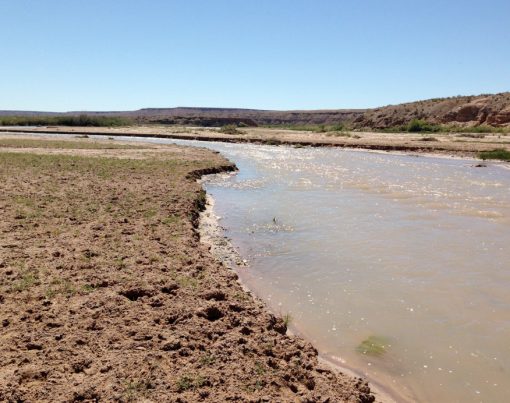
by Deep Green Resistance News Service | Jan 11, 2016 | Biodiversity & Habitat Destruction
By Katie Fite / WildLands Defense
This article first appeared on Counterpunch
Featured Image: Virgin River with banks trampled like a feedlot by Cliven Bundy cattle. May 2015.
In Oregon, an armed occupation of Malheur Wildlife Refuge headquarters is being led by self-proclaimed “patriots” from Nevada. They are defending a public lands ranching family’s “right” to set fires and break the law.
In Nevada, Cliven Bundy owes more than a million dollars in grazing fees. An armed confrontation broke out when BLM began to impound his trespass livestock. The government backed down. For almost two years, no action has been taken while the Bundy camp becomes ever more brazen. This past summer, when Cliven Bundy went to the Nevada legislature to support a bill to turn over federal authority of public land to the state, he was treated to a barbecue by Nevada Congressman Mark Amodei.
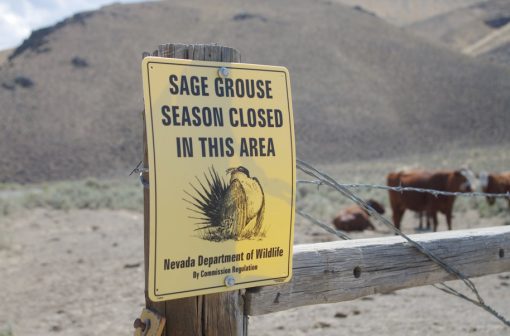
Cliven Bundy is not the only Nevada Rancher being given proprietary treatment by Nevada federal land managers. Settlement deals and BLM coddling reward hostile ranchers at the expense of the public’s land.
Argenta Allotment Settlement
There has been prolonged, severe drought in Nevada. In 2014, defiant public lands ranchers resisted Battle Mountain BLM drought closures and cattle cuts in the Argenta allotment. They were emboldened by the Bundy incident. The ranchers set up a “Grass Camp,” aided by instigator Grant Gerber, across from the BLM office. They have waged an intimidation campaign against agency staff. They whined incessantly to cattle friendly Nevada politicians Amodei and Senator Heller. The Elko paper did not really report, but instead was a worshipful cheerleader against the BLM. The ranchers denied there even was a drought. At the very same time, they received lavish federal drought disaster relief payments.
The cattle damage became so severe that by late summer the local BLM finally closed the sensitive sage-grouse habitats in mountain pastures of the Shoshone Range to grazing. The ranchers and states rights politician John Carpenter appealed the protective closure. In spring 2015, an Interior Department Office of Hearings and Appeals administrative law judge finished review of a mountain of documents, and ruled in favor of the closure.
But within weeks, BLM folded. All of Argenta was again flung open to grazing. Leadership under Nevada BLM Director John Ruhs had forced a settlement deal indulging the ranchers’ every whim. Ruhs, bonded at the hip with the Cattlemen, had been “Acting” Director, and then officially became Nevada Director.

Nevada BLM Director John Ruhs
The deal was greased through by the “National Riparian Team,” composed of livestock industry sycophants from within BLM and the Forest Service, and outside cattle consultants.
The Team, while claiming to be a neutral party, immediately took the ranchers’ side – with Team members railing against perceived interference by the local BLM staff that had sought to control cattle damage to the public lands. So it’s no surprise the settlement flung open sensitive closed sage-grouse habitats to full bore grazing. Herds of several hundred cows were allowed to trample and devour “forage” across the drought-stricken public land in 2015.
The settlement put the Team in charge of a Coordinated Monitoring Group “(CMG”) dominated by ranchers and a token enviro group to take control of monitoring, to direct management actions, and run interference with the local BLM so the Argenta ranchers would not be accountable for grazing damage or trespass.
The cabal bars the public and press from observing their monitoring of grazing damage, and from their closed door discussions that dictate management. The group tells BLM what to do to keep the ranchers happy.
The result has been grazing chaos, and wanton damage of lands and waters. Wildlands Defense (WLD) and colleagues visited Argenta to observe and document conditions. Cattle were scattered all over the allotment, and riparian areas ravaged. When we asked BLM where cows were supposed to be present, the local BLM managers did not even know. All was in the hands of the Team and CMG.
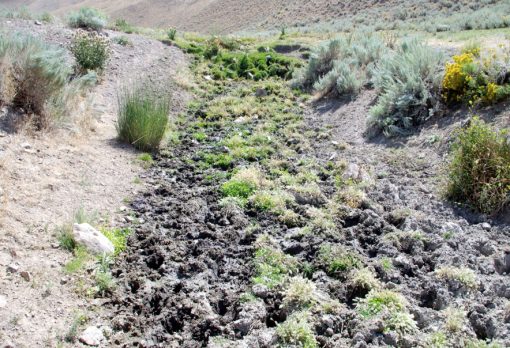
Cattle trampling dries out and destroys sage-grouse brood habitats.
Scads of new cattle projects are also laid out in the settlement. A July Team memo plans new barbed wire fencing and water projects incrementally sprawled across Argenta. The Team embraces injurious grazing practices – severe cattle trampling soil disturbance and high use of native grasses. Why the projects? So ranchers don’t have to work to control their cows. This frontloads Argenta with band-aid fences around prominent degraded areas (and long term monitoring sites) close to roads, prior to any thorough Land Health assessment. There never has been any grazing study since the 1976 passage of FLPMA. The ranchers can then claim conditions within the little fenced areas are “improving,” and insulate against cattle cuts in an assessment.
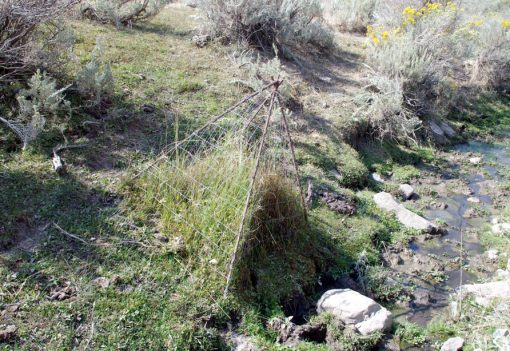
Monitoring cage illustrating how severe cattle use is. Our site visits found such cages destroyed in some areas since the CMG group took over.
This fall, BLM obediently issued a Decision giving the ranchers six new permanent fences, plus “temporary” water troughs and a pipeline. WLD and Wild Horse Education appealed the first battery of projects, which are terrible for wildlife. Sage-grouse and other wildlife are killed by flying into or becoming entangled with wire. The projects also shift intensive impacts onto other areas. We also challenged the Ruhs Settlement – which has altered grazing, established the exclusive closed meetings, and directed the projects. BLM claims we can’t appeal the Settlement.
Now over the holidays, BLM proposed more projects. The ranchers, through the cover of the Team and CMG, are essentially now running the public lands.
North Buffalo Settlement
Days after BLM caved in Argenta, one of the very same permittees, Filippini Ranch, rewarded BLM appeasement efforts by unleashing their cattle on the nearby North Buffalo allotment. North Buffalo, like Argenta, was closed for drought protection. It is home to a very small struggling population of sage-grouse, whose habitat is also being consumed by foreign gold mines.
BLM could not help but notice the cows turned out illegally, since the ranch owner told about the trespass to the Elko newspaper, flaunting his power. Leadership under Ruhs promptly rewarded this trespass with another Settlement deal. Just as in Argenta, a North Buffalo Settlement flung open the closed lands. BLM charged Filippini around $100 for willful trespass – a small price for being allowed access to tens of thousands of dollars worth of public lands “forage” for which the permittees pay a pittance.
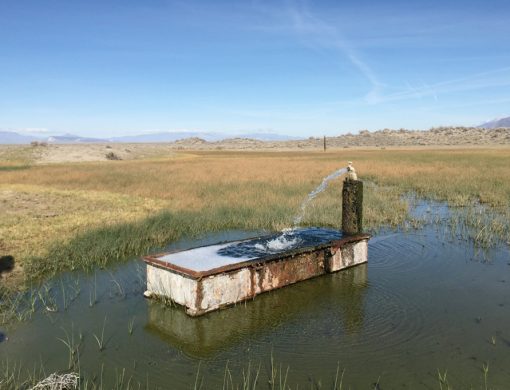
Uncapped abandoned test well site in now Wilderness lands where rancher claimed water rights.
DeLong and Humboldt County Settlement
There is yet another Settlement deal gift to a powerful rancher, this time in Winnemucca BLM lands. The powerful Delong ranching operation and Humboldt County had sued BLM over a raft of access issues primarily involving cattle water projects, many in Wilderness areas with no access roads. The projects had not been recognized by BLM when compiling project lists following the passage of the Black Rock Wilderness legislation in 2000. The lawsuit involved arcane regulations originating in the 1800s and early 1900s. BLM issued a scoping letter this fall proposing to maintain, reconstruct and access 15 cattle projects, access private inholdings, and maintain irrigation ditches – mainly in the North Jackson, South Jackson and Black Rock Wilderness in the South Jackson allotment.
BLM did not tell the public in its confusing letter that the proposal was based on yet another recent Settlement deal. We only learned of this when querying the BLM staff.
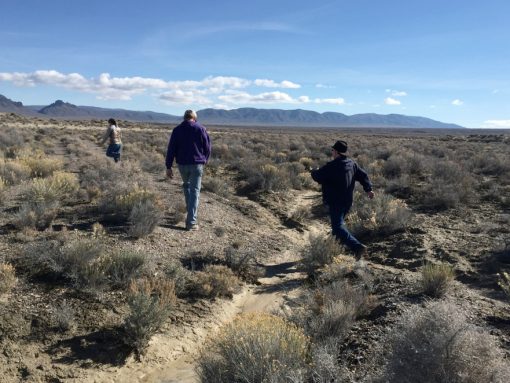
BLM field trip in area where rancher is being allowed access for cattle water project.
Hold Your Wild Horses
BLM leadership has knowingly looked away from a series of purposeful and blatant violations of the Code of Federal Regulations by a rancher (Borba) in the Fish Creek wild horse Herd Management Area in Battle Mountain country.
The rancher was found to be in “willful trespass,” grazing his livestock outside the boundaries of his legally authorized use for eight months. Under pressure from politicians Heller and Amodei, the BLM reduced the trespass and lowered fees.
The rancher and Eureka County also became upset over a local BLM decision to manage wild horses to incrementally reduce the population. The BLM removed over 200 wild horses, and then planned to use the PZP fertility control drug, and release horses given fertility control back to the HMA. In a stand-off reminiscent of an old western movie, the county and rancher showed up onsite and demanded the BLM not release the horses.
The BLM caved, and the horses were hauled away. After a lengthy legal battle the horses were returned to the range months later.
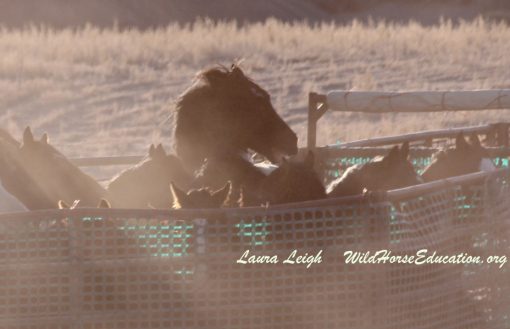
The disgruntled rancher began a social media campaign to rile the public against “government abuse.” Claims were made that he was never in trespass. He videotaped himself repeatedly breaking the law, and put it on social media. The penalties for the acts committed clearly state that the permittee will face fines, possible jail time and “shall” lose the right to graze on public lands.
Ruhs met with the rancher, County and local BLM Manager Furtado at Fish Creek, and sided with cattleman over his own staff. The BLM state office has now put the brakes on the fertility control program for the Fish Creek wild horses. This winter, the permittee is grazing livestock as if nothing happened.
Is It Continued Bungling, Political Interference or Tacit Support?
Badly bungling the Bundy situation and failing to act for almost two years now, the BLM opened the floodgates of rancher defiance and Sagebrush Rebel hell. The Ruhs Settlement deals reward powerful public lands ranchers who hate the agency and the very concept of public good and public lands. Allowing violations of federal law to go unaddressed has created an environment where any concept of law appears meaningless. The Settlements in Argenta, North Buffalo, Jackson Mountain/DeLong, coupled with BLM leadership ignoring blatant Fish Creek rancher law-breaking, embolden the very parties who want to see the public lands become unmanageable by the federal government.
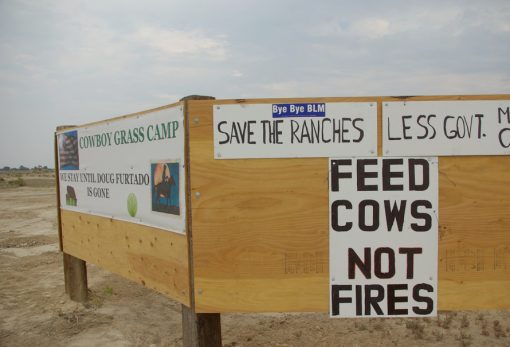
Safety of BLM employees on the ground has been jeopardized. The ranchers want removed anyone who might attempt to protect the environment. Their intimidation campaign is demanding Battle Mountain District Manager Doug Furtado be fired. The local office has been rendered powerless.
Appointment of Ruhs as Nevada Director, sweetheart settlement deals and toleration of overt law-breaking all have taken place under national BLM Director Neil Kornze, a native of Elko, Nevada and son of a mining engineer.
Is this ineptitude on the part of BLM leadership, political interference, or something else? Kornze increasingly appears to be either the most bungling BLM Director ever – or a fellow traveler with the Nevada public Land Grab crowd. While we continue to see PR photos of the BLM Director on outdoor excursions, important areas of the American West are being handed over to the welfare ranchers through a policy of capitulation and appeasement – resulting in a de facto loss of federal control and stealth Land Grab.

by Deep Green Resistance News Service | Jan 5, 2016 | Biodiversity & Habitat Destruction
Once I recovered from the shock I experienced witnessing the carnage produced by a Bureau of Land Management’s (BLM) so-called “pinyon-juniper treatment project” just south of Spruce Mountain in Nevada, all I wanted was the destruction to stop. In order to stop the destruction, we have to ask the question: “Why are they doing this?”
BLM’s justifications [are] moving targets … Once a justification is proved to be based on bad science and incomplete research, BLM throws up a new target.
To learn the answer, I embarked on a long, strange trip through BLM documents, books on pinyon pine trees, YouTube propaganda, and countless scientific articles. I found so many justifications, my head was spinning. On a phone call with staff from the Southern Utah Wilderness Alliance (SUWA), Field Attorney Neal Clark described BLM’s justifications as “moving targets.” Once a justification is proved to be based on bad science and incomplete research, BLM throws up a new target. Meanwhile, the destruction of pinyon-juniper forests intensifies.
The BLM, Carson City District, Sierra Front Field Office is proposing a vegetation treatment project in the Virginia Mountains area north of Reno and west of Pyramid Lake in Washoe County, Nevada. The Virginia Mountains Vegetation Treatment Project would destroy “approximately 30,387 acres” of pinyon-juniper forest.
The BLM’s online notice lists some of the most common excuses used for pinyon-juniper deforestation. Those excuses include: to “reduce the potential of large-scale high severity wild land fire,” “provide for public and firefighter safety and protection of property and infrastructure,” “maintain sagebrush habitat, riparian plant communities, wet meadows, and springs,” and “protect and enhance historic juniper woodland habitat.” In order to achieve these goals, the BLM’s online notice says the “proposed treatments include mechanical mastication, mechanical removal, hand cutting, chemical treatments, chaining, and seeding.”
BLM’s claims in their campaign against pinyon-juniper forests directly contradict the body of scientific literature.
Of course, the notice ends with the currently fashionable nod to protecting greater sage-grouse habitat and reads, “treatments would be designed to address threats to greater sage-grouse from invasive annual grasses, wildfires, and conifer expansion.”
When BLM claims that their proposed pinyon-juniper treatment projects will achieve the results like the ones listed in the Carson City District, Sierra Front Field Office’s notice, they are making claims that are not supported by scientific research. In fact, many of BLM’s claims in their campaign against pinyon-juniper forests directly contradict the body of scientific literature.
Since I began researching pinyon-juniper forests, writing this Pinyon-Juniper Forest series, and participating in a grass-roots campaign to demand a nationwide moratorium on pinyon-juniper deforestation, I have heard BLM’s claims replicated many times. It is time their erroneous assertions are put to rest. In this essay, I will address the common justifications BLM uses for destroying pinyon-juniper forests and show how BLM is lying.
***
The first reason BLM’s Carson City District, Sierra Front Field Office uses to support its proposal to clear-cut 30,387 acres of living forest is typical in the nationwide assault on pinyon-juniper forests. BLM claims their proposed project will “reduce the potential of large-scale high severity wild land fire.” According to BLM, this will “provide for public and firefighter safety and protection of property and infrastructure.”
BLM’s justification suggests that there is a serious potential for high severity, wild land fire in pinyon-juniper forests, but is that true?
William L. Baker and Douglas Shinneman wrote an article “Fire and Restoration of Piñon-Juniper Woodlands in the Western United States: A Review” (PDF) which is considered one of the leading reviews of fire incidence in pinyon-juniper forests. Baker and Shinneman argue that there simply is not enough scientific evidence for land managers to apply uniform fire and structural treatments like BLM’s proposed Virginia Mountains Treatment Project in pinyon-juniper forests.
[The BLM’s proposed] treatments have actually been found to increase pinyon-juniper forests’ potential for burning.
Not only are scientists cautioning BLM not to assume pinyon-juniper forests have a serious risk of large scale fire, mechanical treatments have actually been found to increase pinyon-juniper forests’ potential for burning. Allison Jones, Jim Catlin, and Emanuel Vazquez, working for the Wild Utah Project, wrote an essay titled “Mechanical Treatment of Piñon-Juniper and Sagebrush Systems in the Intermountain West: A Review of the Literature” (PDF). Their essay is a comprehensive review of the scientific literature surrounding pinyon-juniper forests and their review undermines many of the goals often given as the reasons for prescribed mechanical treatments of pinyon-juniper forests.
In regards to using pinyon-juniper mechanical treatment as a tool for reducing the potential of wild land fire, Jones et al. write, “There are… many studies that report when piñon-juniper is mechanically treated and if cheatgrass and/or other exotic annuals are present in the system before treatment, then cover of these species will increase post-treatment.” Cheatgrass, of course, is an invasive species that quickly outcompetes native grasses. The relevant problem with cheatgrass is that it is more flammable. When cheatgrass dominates rangelands, it speeds up the natural fire interval of those rangelands. In other words, cheatgrass makes the land it occupies more prone to wild fires.
Regardless of what BLM says, what they are actually doing is contributing to global climate change, a longer wildfire season at home, and hastening the destruction of the entire planet.
When BLM rips up pinyon-juniper forests in the interests of reducing the potential for wildfires, their destruction produces the opposite of their stated goal. Instead of providing for public and firefighter safety, BLM is actually making it easier for cheatgrass to choke out native species which in turn makes it more likely the Great Basin will burn. On the global scale, we know that deforestation speeds climate change. Trees sequester carbon and the prevalence of carbon dioxide in the atmosphere is a leading cause of climate change. Warming climates lead to longer and more intense wildfire seasons. Wildfires burn forests releasing more carbon dioxide into the atmosphere and the vicious cycle intensifies. Regardless of what BLM says, what they are actually doing is contributing to global climate change, a longer wildfire season at home, and hastening the destruction of the entire planet. “Public and firefighter safety”? Hardly.
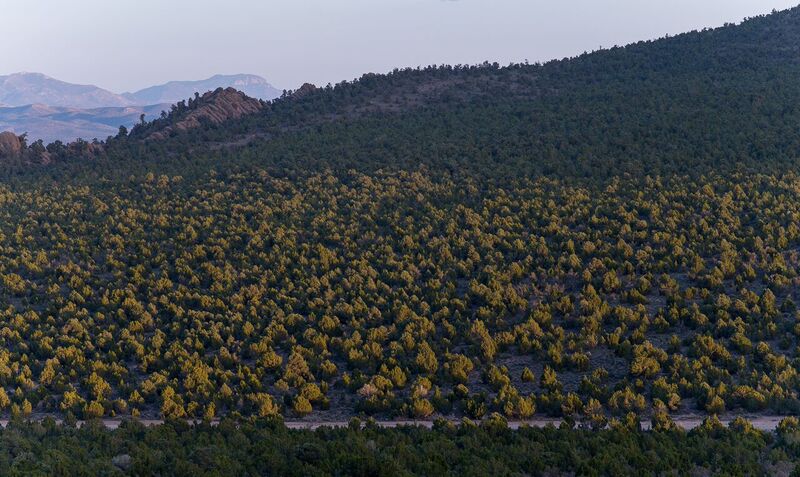
Healthy Pinyon-Juniper forest (Photo: Max Wilbert)
The next justification BLM’s Carson City District, Sierra Front Field Office lists for why it must destroy pinyon-juniper forests is to “maintain sagebrush habitat, riparian plant communities, wet meadows, and springs.” Before I address this justification, remember that BLM plans to maintain different plant habitats through processes like chaining tens of thousands of acres of living forest. Chaining, you may recall, involves stretching an anchor chain from a US Navy battleship between two trawler tractors and dragging the chain across the forest floor ripping up everything the tractors’ path. Chaining, BLM claims, improves sagebrush habitat, riparian plant communities, wet meadows, and springs.
There are two mistaken beliefs underlying BLM’s stated goal to maintain sage brush habitat, riparian plant communities, wet meadows, and springs. The first idea is rooted in BLM dogma that insists that pinyon-juniper forests are “encroaching” into lands (including sagebrush habitat) they did not previously occupy. The second idea accuses pinyon pine and juniper trees of somehow using too much water and hypothesizes that cutting these trees will lead to increased water yield. Both of these arguments have been soundly defeated in scientific literature.
The pinyon-juniper encroachment theory is a product of settler colonialism’s historical amnesia. One of the products of the white supremacy brought to the Great Basin by European settlers is a selective memory that ignores guilt-inducing facts of ecological destruction wrought on the Great Basin by European mining activities.
When BLM claims pinyon-juniper forests are encroaching, the forests are actually recovering from the shock of European development.
Pinyon pine expert Ronald Lanner described the catastrophic destruction of pinyon-juniper forests in Nevada in his book “The Piñon-Pine: A Natural and Cultural History.” Lanner explains how pinyon and juniper wood was essential for fuel for smelting operations, lumber for buildings in boom towns, and as mine supports in mine-shaft construction. Lanner says western Nevada’s Comstock mines used 18 million board feet of pinyon-juniper timber annually while Eureka, Nevada burned 17,850 bushels of pinyon-juniper charcoal daily. Lanner explains that by 1870 – a mere 11 years after the European discovery of silver in Nevada – charcoal makers had denuded forests for a 50 miles around Eureka, NV.
When BLM claims pinyon-juniper forests are encroaching, the forests are actually recovering from the shock of European development. It wasn’t just mining, either. Lanner estimates that 3 million acres of pinyon-juniper forests were destroyed to make room for cattle between 1960 and 1972 in the Great Basin and Intermountain West. Jones et al. explain that “what we see today in many cases is piñon-juniper simply recolonizing places where they were dominant but then gained in the 1940s to 1970s.” They go on to state, “what is actually natural recolonization is often mistaken for encroachment.”
A classic accusation hurled at juniper trees in particular is that they consume more water through their roots compared to other plants where junipers live. Jones et al. cite 8 recent studies to state that this simply is not the case. Jones et. al also demonstrate that mechanical treatments of pinyon-juniper forests do not produce the effects BLM wants the treatments to: “There are many indications from the literature that mechanical piñon-juniper…treatment, especially if followed by mechanical drill seeding, can fail to meet the goals of ‘ecological restoration and watershed health and productivity.” The seedings enable grazing by large herds of cattle that also disturb the soil crusts and cause flammable cheatgrass to proliferate.
Why do these mechanical treatment projects fail to promote restoration? They fail to promote restoration because, as Jones et al. explain, mechanical treatments are extremely destructive to biological crusts. Additionally, Jones et al. point out how mechanical treatments like chaining lead to the greatest degree of soil disturbance. And, soil losses due to erosion following destructive activities like chaining can take 5,000 to 10,000 years to reform.
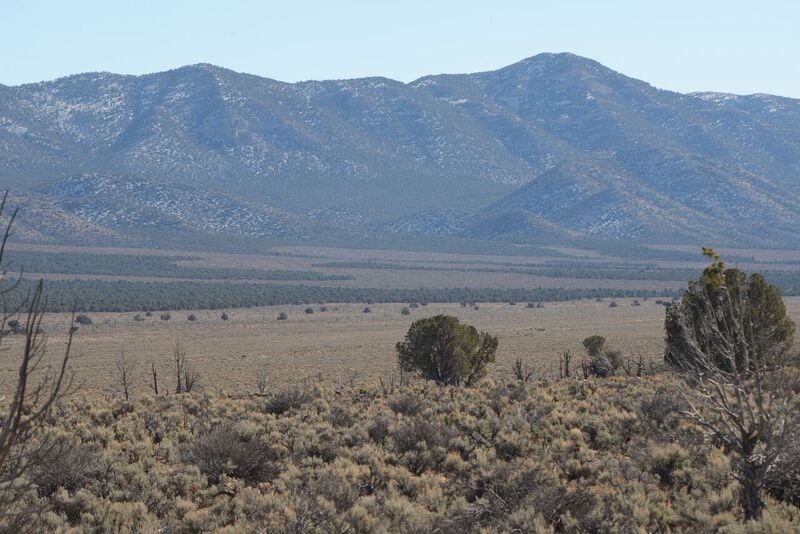
Wide view of Pinyon-Juniper clear-cuts (Photo: Max Wilbert)
Next, we have BLM’s claim that their Virginia Mountains Vegetation Treatment Project will “protect and enhance historic juniper woodland habitat.” Again, even without the science, it is difficult to understand how dragging a giant chain across a forest floor to rip up pinyon pine and juniper trees by their roots can protect and enhance the very juniper trees being destroyed. As you might expect, the science reveals the lunacy in BLM’s stated goal.
In addition to the way mechanical treatments of pinyon-juniper forests destroy a natural community’s biologic crust and lead to practically irreversible soil loss, Jones et al, describe how mechanical drill seeding or mechanical clearing of dead pinyon-juniper trees after a fire “can lead to significantly increased wind erosion…” They also state that, “there are many examples in the literature of cases where mechanical clearing of piñon-juniper has led to increases in erosion by both air and water.” And finally, they remind us that “any kind of land treatment that clears the existing vegetation and disturbs the soil (so all mechanical treatments but also fire and chemical treatments) can result in increases in exotic annuals, especially cheat grass, when these species are present in the system before treatment.”
It is quite clear, then, treatment projects like the proposed Virginia Mountains Vegetation Treatment Project do not protect and enhance historic juniper woodland habitat. These projects destroy historic juniper woodland habitat and seriously degrade the ecosystems they are found in.
***
Protecting greater sage-grouse habitat has become the newest justification for pinyon-juniper deforestation and BLM explains that the Virginia Mountains Treatment Project “would be designed to address threats to greater sage-grouse from invasive annual grasses, wildfires, and conifer expansion.”
These lists of threats to greater sage-grouse suggest that if BLM was truly interested in protecting the birds, they would spend their energy combating oil and gas development, conversion of land for agricultural use, and climate change.
First, we should double-check precisely what are the threats to greater sage-grouse. The World Wildlife Fund, for example, takes a slightly different perspective than BLM saying, “Unfortunately, because of oil and gas development, conversion of land for agricultural use, climate change and human development, sage grouse only inhabit half their historic range.” A similar website run by Defenders of Wildlife echoes WWF, “Remaining sagebrush habitat is fragmented and degraded by oil and gas drilling, livestock grazing, mining, unnatural fire, invasive weeds, off-road vehicles, roads, fences, pipelines and utility corridors.”
These lists of threats to greater sage-grouse suggest that if BLM was truly interested in protecting the birds, they would spend their energy combating oil and gas development, conversion of land for agricultural use, and climate change. I will play BLM’s game, though, to discover if mechanical treatments really will produce the results BLM thinks they will.
They will not, of course. Jones et al. made it clear that mechanical treatments of pinyon-juniper forests pave the way for invasive annual grasses to dominate treated areas. Invasive annual grasses choke the ground surface with continuous fuel, and burn more easily than clumped native bunchgrasses. And, as I wrote earlier, “mechanical treatments” are codespeak for deforestation. Deforestation leads to accelerated climate change which leads to more wildfires which kill greater sage-grouse.
I have already cited Lanner and Jones et al. (who cite many, many more) to explain that “conifer expansion” in most places is not really happening. This time, I want to address this argument from a psychological level. Notice how BLM is blaming conifer expansion for greater sage-grouse habitat loss while many other organizations are blaming oil and gas development, agricultural conversion, and mining. These other organizations, in other words, are blaming human expansion for greater sage-grouse habitat loss. When BLM’s rhetoric is viewed in this way, it becomes possible to analyze BLM’s words as a psychological distraction away from the role of humans in the destruction of the Great Basin. It is easier to blame trees than it is to blame humans for the deterioration of the Great Basin. Maybe this explains why so many readily accept BLM’s bogus arguments?
***
Learning that BLM is mistaken or spreading downright lies about what they’re doing to pinyon-juniper forests, the question, again, becomes, “Why?”
Why are they lying? How have they convinced themselves this is acceptable? Are they so beholden to ranching interests that their rationality has been destroyed by cattle money? Do they truly think they are doing what is best for the lands they “manage?” Or, with the amount of destruction they are wreaking on the Great Basin, do they hate pinyon-juniper forests?
I think there must be good-hearted people working for BLM who truly do care for the Great Basin. I wonder how they could have been misled in this way. I recall an article I recently read by Robert Jay Lifton, the brilliant psychologist who asked these very same questions of those involved in the rise of Nazism in his book “The Nazi Doctors.” Lifton’s article appeared in the New York Times and was called “The Climate Swerve” about the world’s deepening awareness of climate change.
Whether [the BLM staff] believe their false claims to virtue or not, is irrelevant for the thousands of acres of beautiful, ancient pinyon-juniper forests set to be destroyed by BLM. What matters is that we stop them.
In the article, Lifton explains, “Over the course of my work I have come to the realization that it is very difficult to endanger or kill large numbers of people except with a claim to virtue.” I would extend his realization to the natural world and explain that BLM’s justifications stand as their claims to virtue clearing their conscience before they murder millions of trees and the beings who live in them. The only way BLM can cut 30,387 acres of pinyon-juniper forests is to claim they are “protecting the public and firefighters” or “enhancing historic juniper woodland habitat” or addressing “threats to greater sage-grouse” so they do not have to face the truth of their violence.
Whether they believe their false claims to virtue or not, is irrelevant for the thousands of acres of beautiful, ancient pinyon-juniper forests set to be destroyed by BLM. What matters is that we stop them.
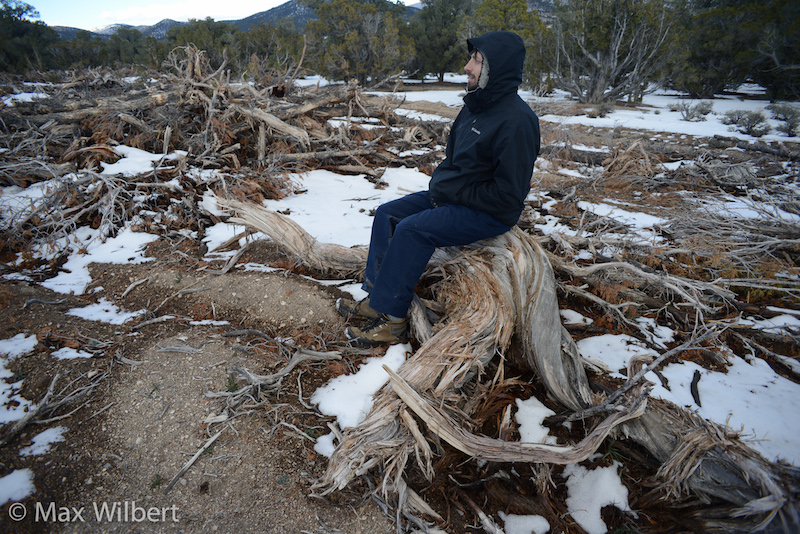
by DGR Colorado Plateau | Dec 13, 2015 | Biodiversity & Habitat Destruction, Listening to the Land, Mining & Drilling
My thoughts race with yesterday. My friend Max Wilbert and I left Park City, Utah in the pre-dawn bitter cold crossing the Wasatch Mountains that form the eastern edge of the Great Basin. The drive west from Salt Lake City on I-80 is disorienting. We began the journey with the radio on. We both became too frustrated by news of another politician refusing to accept refugees, so we turned the radio off to watch the land as we traveled.
Interstate 80 took us past the sites of some of the West’s most destructive extraction industries including Kennecott Copper’s Bingham Canyon Mine. The Oquirrh Mountains stand tall on the Salt Lake Valley’s west side, each peak a majestic testament to the forces of beauty who formed the Great Basin.
Each peak, save one.
With the destruction of the mountain peak and subsequent release of heavy metals, the Bingham Canyon mine is responsible for the deaths of countless migratory birds and their homes
The Bingham Canyon Mine – the continent’s largest open-pit copper mine impacting close to 80 square miles in the Salt Lake Valley – ripped one of the peaks off to disembowel copper from the land. Not far past the pit, stretches the mine’s smelting and tailings pond. The pond, which seems big enough to be called a lake, runs parallel to the Great Salt Lake, one of the Western Hemisphere’s most significant migratory bird habitats. At some places, tailings water sits merely yards from the Great Salt Lake. Mining activities and the tailings pond release selenium, copper, arsenic, lead, zinc, and cadmium into the Lake. With the destruction of the mountain peak and subsequent release of heavy metals, the Bingham Canyon mine is responsible for the deaths of countless migratory birds and their homes including wetlands, marshes, other freshwater wildlife habitats, and freshwater ponds.
After we drove by the casinos in Wendover and the brothels in Ely, we spent the day on the southern slopes of Spruce Mountain walking through a pinyon-juniper forest clear-cut. We met up with biologist and Great Basin expert, Katie Fite, who narrated the history of environmental degradation in the region.
Today, after the travel, seeing the clear-cut, and hearing about the tragic history of the Great Basin, my head is reeling. I crave time and space. I crave simply to locate myself.
The trunk I lean against is the trunk of a tree lost in another clear-cut. I do not want to see clear-cuts anymore, so I face away from the carnage. Behind me are the scattered corpses of pinyon-pine and juniper. Many of these trees were two or three hundred years old and had watched countless of the Great Basin’s arid summers and bitter winters. The pinyon-pines had offered up their delicious nuts to birds like turkeys, Clark’s nutcrackers, Steller’s jays, scrub jays, and pinyon jays as well as wood rats, bears, deer and humans for centuries.
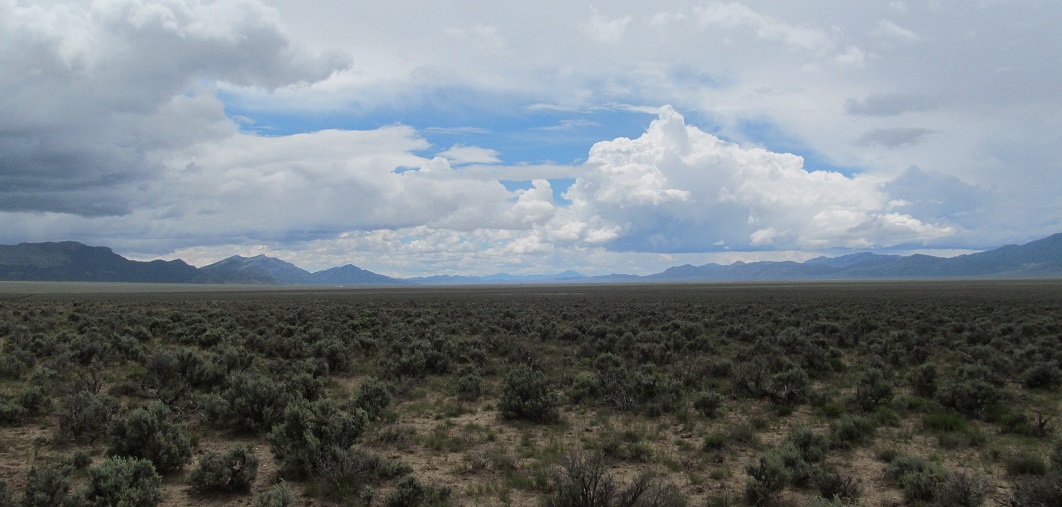
Cave Valley.
With my back turned to the clear-cut, the wide, clear sky, the drama tracing the sharp mountainsides, and the seemingly eternal evenness of the Cave Valley floor creates a vastness that overpowers any inclination I possess towards my own importance.
I am so small here.
I want to pray, but I hesitate because I wonder what relationship I have earned with life here to engage in sincere prayer. I wonder how I must appear to the trees. With my white skin, European genealogy, dark beard, and heavy boots, I must look like so many of the settlers who have damaged this valley before. Have these forests suffered too much trauma to welcome people who look like me? Surely, their most effective survival strategy must be to shut me out.
I want to ask this valley what I can do for life here. I remember that prayer need not involve asking for anything. I sink into the twigs and frost on the ground where I sit. I try to seep into the valley letting myself spill across the landscape.
I remember a strange sensation I experienced not long ago driving through Price, Utah – coal country. Driving parallel to a long stretch of train tracks, through dynamited rock formations, I thought of the Irish – my kin – who must have been involved in building the railroads that lacerate open lands across the West. I asked aloud about what it must have been like for a young Irishman, no older than me, who was asked by his family to leave home and seek work in America because they could no longer feed him. I asked how strange it must have been for him to stand on the docks at Cork wondering if he’d ever embrace his mother again. Then, to pause in the oppressive Utah sun considering the same embrace while digging graves for his friends after a dynamite accident – all in the course of a year.
I feel a sense of ancestral guilt here in Cave Valley knowing that those same railroads opened up Nevada’s remote places to the cattle and sheep grazing destroying the land. Even so, I want to ask this valley what I can do for life here. I remember that prayer need not involve asking for anything. I sink into the twigs and frost on the ground where I sit. I try to seep into the valley letting myself spill across the landscape. I wish the wind would carry me through the sage brush and up the slopes into the living pinyon-juniper forests. The wind stirs. Wind is an invisible being only coming close to being seen when it dries my eyes out, or dances with the trees.
The contrast of the wind’s chill and the sun’s warmth is a sensuous experience of the purest kind. I grow bold. I ask the valley what it wants me to know.
I ask the valley what it wants me to know. As the question forms in my consciousness, the blue wings of a pinyon jay catch my attention.
As the question forms in my consciousness, the blue wings of a pinyon jay catch my attention. The jay is flying swiftly through the clear-cut. She seems aware of her vulnerability with no cover in the void. She lands on a stump, searches around, and pulls up a pinyon pine cone. She shakes it and pecks at it with her beak, but finds no nuts. She pulls another cone up, and again finds no nuts. I watch her fly from stump to stump, felled trunk to felled trunk, and still she finds no nuts. Finally, the voices of my companions returning from their hike carry over the ridge line. The pinyon jay darts quickly across the open and back into the living forest finding refuge in standing pinyon pines and junipers.

Pinyon Jay. Image by Robert Harrington.
I was asked by my friends to write about pinyon-juniper forests because they are being clear-cut by the Bureau of Land Management, but before I wrote about them, I knew I needed to visit the forests in an effort to understand what needs to be said. Of course, my prayer was answered. Life speaks in patterns. When a story-teller sits down to communicate her experiences in a manner that will make sense to her listeners, she may recognize those patterns and hear life speaking there.
My trip to pinyon-juniper forests in Nevada began with news of the refugee crisis. The journey continued past places where mining destroys the homes of migratory birds, fish, and so many others who depend on the precious-little freshwater near the Great Salt Lake. From there, I witnessed the ruins of pinyon-juniper forests. Not only are these forests populated with ancient, hardy trees who generously offer their pine nuts and juniper berries, but the forests are home to an estimated 450 species of vascular plants and over 150 vertebrate species. Birds live there. Wood rats live there. Deer live there. Elk live there. The Shoshones, the Goshutes, the Paiutes, all live there. All these non-humans and humans are made into refugees by the clear-cutting of pinyon-juniper forests just like the lone pinyon jay I was shown when I asked what I needed to know.
When we peer into the past with Earth’s memories, we see thousands of years of refugees. … Countless species call the world’s forests home, so when we witness deforestation, we are witnessing a refugee crisis.
The recent news on the refugee crisis encourages us to think only of boats filled with human refugees sinking on the way to Europe. These events are most tragic and the refugee crisis is by no means new nor is it limited to humans.
When we peer into the past with Earth’s memories, we see thousands of years of refugees. We see 80% of the world’s forest cover lost to deforestation. We see countless animals fleeing the thunk of axes as blades sink into the living flesh of trees. We see birds circling their young in nests built in quivering branches as we hear the hungry buzz of saws and the sickening crack and snap as trunks break. Countless species call the world’s forests home, so when we witness deforestation, we are witnessing a refugee crisis.
We see more than 75% of the topsoil that existed worldwide when Europeans first colonized North America is now gone. We watch as the plows rip through the skin of the land and the world’s forests to make way for the cultivation of annual crops. Subsistence farming is responsible for 46% of world deforestation, while commercial agriculture is responsible for 32%. Another way to say this is countless species have their homes destroyed so that one species – typically a grain – have a place to thrive.
Ripping metals from the earth creates refugees out of those who call the ground and dark subterranean regions home.
We see 60% of the world’s major rivers fragmented by dams and diversions (PDF). Some of the world’s greatest rivers such as the Nile, the Indus, and the Colorado no longer flow to the sea. For aquatic life, a dam is often an impenetrable wall. We see salmon wanting to return to their spawning beds, wanting to return home, so badly they batter their heads against concrete walls. They struggle so fiercely against the dams river water turns crimson with salmon blood. Dams isolate communities and keep non-humans from coming home as surely as the Berlin Wall of the Cold War separated Germans or the border fences in California, Arizona, and Texas alienate Americans, Mexicans, and indigenous peoples from each other.
While Earth remembers a refugee crisis thousands of years old, the Great Basin’s memories are full of relative peace characterized by humans like the Shoshone, Goshutes, and Paiutes among others living sustainably taking only as much as the land freely gave. It was the discovery of a great silver lode in Comstock, Nevada in the 1850s that brought European settlers en masse and started the refugee crisis in the Great Basin.
Ripping metals from the earth creates refugees out of those who call the ground and dark, subterranean regions home. Additionally, silver is extremely difficult to smelt requiring huge amounts of charcoal produced from burning huge amounts of local pinyon pines and junipers at high enough temperatures to separate silver from the stones it clings to so desperately.
Pinyon-juniper deforestation sends 150 vertebrate species fleeing from their cut homes while 450 plant species have no legs to run with.
I used Ronald Lanner’s statistic in my first essay on pinyon-juniper forests, “An Ancient Vision Disturbed,” but the quantity of trees destroyed for silver mining in Nevada is so staggering the statistic needs repeating. Lanner explains in his brilliant work, The Pinon Pine: A Natural and Cultural History: “A typical yield of pinyon pine was ten cords per acre, and a cord made about 30 bushels of charcoal. So, the furnaces of Eureka, working at capacity, could in a single day devour over 530 cords of pinyon, the produce of over 50 acres. An additional 20 acres a day were being cut to provide cordwood for the mills. After one year of major activity, the hills around Eureka were bare of trees for ten miles in every direction. By 1874, the wasteland extended twenty miles from town, and by 1878 the woodland was nowhere closer than fifty miles from Eureka.”
With the Great Basin experiencing over 50 acres of pinyon pine devoured by silver mining furnaces in Eureka per day, thousands of non-humans were made homeless by silver mining in Nevada each day, too.
Pinyon-juniper deforestation sends 150 vertebrate species fleeing from their cut homes while 450 plant species have no legs to run with. Ancient pinyon pine and juniper trees continue to grow their roots deeper and deeper into endangered ground. They’ve felt their kin cut and cut again. They’ve felt the jays fly away, the rabbits scamper into the brush, and the deer sprint from the axemen.
In the Great Basin, refugees beget refugees. European settlers who physically performed the most destructive job were in many cases refugees from war and economic crisis in their homelands.
European settlement brought populations of humans that the land simply could not support naturally. All those people had to eat. So, cattle grazing was introduced to the semi-arid lands of the Great Basin. It wasn’t long before cattle ate away native grasses and destructive, invasive grasses were imported to support cattle populations. The ranchers became jealous of pinyon-juniper forests and a new motivation for deforestation led to more of the forests being cleared.
In the Great Basin, refugees beget refugees. European settlers who physically performed the most destructive job were in many cases refugees from war and economic crisis in their homelands. My ancestors, the Irish, endured centuries of British domination and a wave of Irish fled starvation when the Great Famine struck Ireland a few years before the Great Basin was settled. Many Irish were involved in building railroads and in mining in Nevada. Richer European settlers – the mining bosses and ranch owners – possessed too much capital to be thought of as refugees in the traditional sense, but they demonstrated a certain spiritual disease produced by the belief that humans can safely take more from the land than the land freely gives.
Exploitation of the land initiates a cycle of violence that is pushing the world to near total collapse.
These European refugees forced the Great Basin’s indigenous peoples into becoming refugees in their own homelands. Lanner describes the violence visited up the Shoshone near Austin, Nevada. The mining and urban activities in the area quickly consumed huge tracts of pinyon-juniper forests which served as the Shoshones’ primary winter food source. With their food depleted, the Shoshones were forced to work for wages in the only two industries operating in Nevada: mining and ranching. “The more these food sources were destroyed, the more dependent the Indians became on wages; and the more they engaged in lumbering and ranching for white men, the more they destroyed their food sources. By the time the bubble burst in the 1880s and 1890s when the mining industry collapsed, the pinyon groves were gone, the valley grasslands were fenced for cattle, and much of the old culture was forsaken.”
As these memories should demonstrate, the exploitation of the land is the source of the oldest refugee crisis. Exploitation of the land initiates a cycle of violence that is pushing the world to near total collapse. Some human cultures have literally eaten themselves out of house and home and continue to require new lands to fuel their way of life. As wider and wider swaths of land are destroyed, communities are encountered that refuse to vacate their homes. But, those who exploit the land gain short term advantages over those who refuse to exploit. Those who refuse to exploit are forced from their homes or killed by weapons made possible by the exploitation of the land and their homes are devastated by technologies similarly made by possible by exploitation.
When the exploiters destroy the possibility of relationship in their minds, they destroy their possibility of belonging, spiritually, to the land. They become refugees.
Spiritual refugees flow from and are created by the land’s exploitation. Before the land, human, and non-human others can be exploited, the exploiters must convince themselves they are somehow superior to these others. The possibility of relationship between exploiter and exploited is forsaken.
The exploiters no longer view mountains as powerful beings patiently watching time pass over the land; mountains are viewed as simple piles of dirt. Animals are no longer treated like relatives capable of teaching humans great lessons; animals are treated like unthinking, unfeeling bags of meat. Rivers are no longer recognized as great dancers, twisting, turning, and writhing in their long beds; rivers are viewed as puddles of water to be drained for farming. When the exploiters destroy the possibility of relationship in their minds, they destroy their possibility of belonging, spiritually, to the land. They become refugees.
In living, and in dying, pinyon-juniper forests offer more to life than they took away. They do not exploit, they do not force others to be refugees. They stand, hardy and still, completely confident in their own belonging.
Pinyon pine and juniper trees are intimately familiar with the refugee crisis. Yet, they cannot flee for refuge themselves. They also offer a lesson for solving the refugee crisis. Pinyon-juniper forests, in simply existing, are inherently beneficent. By simply growing, they sequester carbon and aid in slowing climate change. By simply seeking to reproduce, they create food for countless others. When they die, naturally, their wood become homes for birds, rats, and other animals. In living, and in dying, pinyon-juniper forests offer more to life than they took away. They do not exploit, they do not force others to be refugees. They stand, hardy and still, completely confident in their own belonging.

by DGR Colorado Plateau | Dec 1, 2015 | Biodiversity & Habitat Destruction, Listening to the Land, Mining & Drilling
By Will Falk / Deep Green Resistance
Standing in a pinyon-juniper forest on a high slope above Cave Valley not far from Ely, Nevada, I am lost in an ancient vision. It is a vision born under sublime skies stretching above wide, flat valleys bounded by the dramatic mountains of the Great Basin. The vision grows with the rising flames of morning in the east. The night was cold, but clear, and the sun brings a welcome warmth. When the sun crests the mountains, red and orange clouds stream across the sky while shadows pull back from the valley floor to reveal pronghorn antelope dancing through the sage brush. A few ridge lines away, the clatter of talus accompanies the movement of bighorn sheep. The slap and crack of bighorn rams clashing their heads together echoes through the valley.
As the morning passes, the sun shines through pine needles and juniper branches to dapple the forest floor in silvers and golds. The trees offer shade where patches of snow glimmer and whisper with the smallest sounds of melting. Pinyon pine cones are scattered across the ground. As they open, their seeds – delicious, nourishing pine nuts – become visible. Beautiful, blue-feathered pinyon jays gather the nuts in their beak before flying off to cache them for the deepening winter.
Humans have long participated in this vision though the vision is far older than them. From a place deeper than my mind’s memory, in the memories of the borrowed materials forming my body, I feel a kinship to this land’s original peoples. For thousands of years, in this part of the Great Basin, Shoshones and Goshutes have stood looking out at valleys like this one as they gathered the pine nuts that provided the most important winter food source making it possible for humans to live in the Great Basin’s harsh climate.
As I let my memory flow into the past, I see hundreds of generations of Shoshones and Goshutes living well off the gifts the land freely gives. Living in this way, I know their relationship with the land could have lasted forever. Pinyon pines could have gone on offering their pine nuts to jays, rats, and humans. Junipers could have gone on twisting in wooden gymnastics and growing their bundles of blue berries.
A herd of cattle catches my attention and I remember that this is just a vision, after all. The presence of cattle, here, forces me to confront the reality of the Great Basin’s ongoing destruction. An anxiety accompanies the cattle. It is the anxiety that flows from the knowledge of ecological collapse. I envy the hundreds of generations of Shoshones and Goshutes who had no reason to question the eternity of their culture.
Following the slow steps of brown and black cows, I see a metallic glint on the valley floor where streamers are tied onto fences built by ranchers so that sage grouse will not fly into the fences and kill themselves. I have seen the bundles of feathers and blood mangled and stuck in the wire fences. The cattle march to a shallow pond. A thin, but growing ring of algae floats on the pond’s surface while piles of cow shit litter sandy soil stripped of any vegetation. From the pond comes a strangled, gurgling sound. Despite the drought, water is being pumped from already strained wells to support the cattle.
The valley floor is striped in green and yellow patches. The green patches represent healthy, native sage brush and the yellow patches represent invasive crested wheat grass. I have learned how in the 1950s and 60s, the Bureau of Land Management (BLM) initiated a series of projects designed to strip away sage brush to replace it with imported Asian crested wheat grass. Not long after white settlement cattle herds wiped out most of the native grasses in the Great Basin, so now the land must be forced to support them. Destroying the sage brush has had disastrous consequences including contributing to the collapse of sage grouse populations who, as their name suggests, require healthy sage brush for habitat.
Above the valley floors, where the pinyon-juniper forests drape across the mountains’ shoulders, are brown swaths cut into the land where the forests have fallen victim to the BLM’s so-called “vegetation treatment projects.” These vegetation treatment projects are really just clear-cuts justified by the BLM as “providing woodland products to the public,” “maintaining sage brush habitat,” and “protection of property and infrastructure.”
As my experience of this ancient vision disintegrates with the reminders of the processes threatening life in the Great Basin, I remember why I came here. I came, specifically, because I had heard of the BLM’s practice of clear-cutting pinyon-juniper forests. Friends of mine asked me to write about threats to pinyon-juniper forests. I had never seen a clear-cut pinyon-juniper forest before, I knew very little about the Great Basin at all, and I’ve always thought the best way to write about the land is to seek a true relationship with it.
So, my friend, the great activist, writer, and photographer Max Wilbert flew to Salt Lake from Eugene, Oregon and we made plans to drive from my home in Park City, Utah to Nevada to see both living pinyon-juniper forests and clear-cuts. We met up with Katie Fite, a biologist and the Board Secretary for the environmental protection group, WildLands Defense. Katie brings over 30 years of on-the-ground experience to environmental advocacy possessing expertise in the Great Basin’s ecology.
***
I walk through the shades and shadows of a healthy pinyon-juniper forest. Songbirds create their music celebrating the beauty of their home. Social ravens gossip back and forth diving down to ask who I am. From time to time, I catch a grey glimpse of a rabbit bounding out of my path. The gentle hooting of an owl falls from the treetops. Though I am several hundred yards from any of my companions separated by ridge lines and hundreds of trees, I do not feel alone. A sense of deep familiarity, the feeling shared when friends gather, settles over me.
It is the 19th of November. The full cycle of seasons in the Great Basin carries the range of temperature extremes. The summers are dry and hot and the winters are frigid with plenty of snow. Even a single day in the Great Basin reflects these extremes. Last night dropped below freezing and I woke with a crisp layer of frost on my sleeping bag at dawn.
In the cold times like these, the slopes of the mountains are the warmest places to be because as the sun comes up and heats the air on the valley floor, the warm air rises. The slopes of the mountains are also where the pinyon-juniper forests are. By mid-morning, the sun is strong and hot. Even though the temperatures fell into the teens Fahrenheit last night, the temperature gains the 60s by noon. The forests, then, are the most comfortable places to be in both the cold night and the hot day. The forests are warmer at night and in the morning than the valley floors, and when the sun beats down during the day the trees offer soothing shade.
It feels, to me, that these ancient pinyon-juniper forests enjoy caring for humans.
I feel I could walk through the forest like this for miles. Then, the trees abruptly stop. The shade ceases and the sun strikes my eyes with a physical force. A cold wind, driven wild over unbroken space, slaps my face. The sudden openness is a shock. I almost trip. Behind me is a living forest, before me is a void.
I have stepped into a clear-cut.
To my left for a mile, to my right for a mile, and a quarter mile across, the land is brown. The long limbs of pinyon pines slump across the gnarled trunks of junipers. I have only seen pictures of human massacre sites. Bodies, frozen and stiff, heaped in piles. And these clear-cuts are truly tree massacre sites.
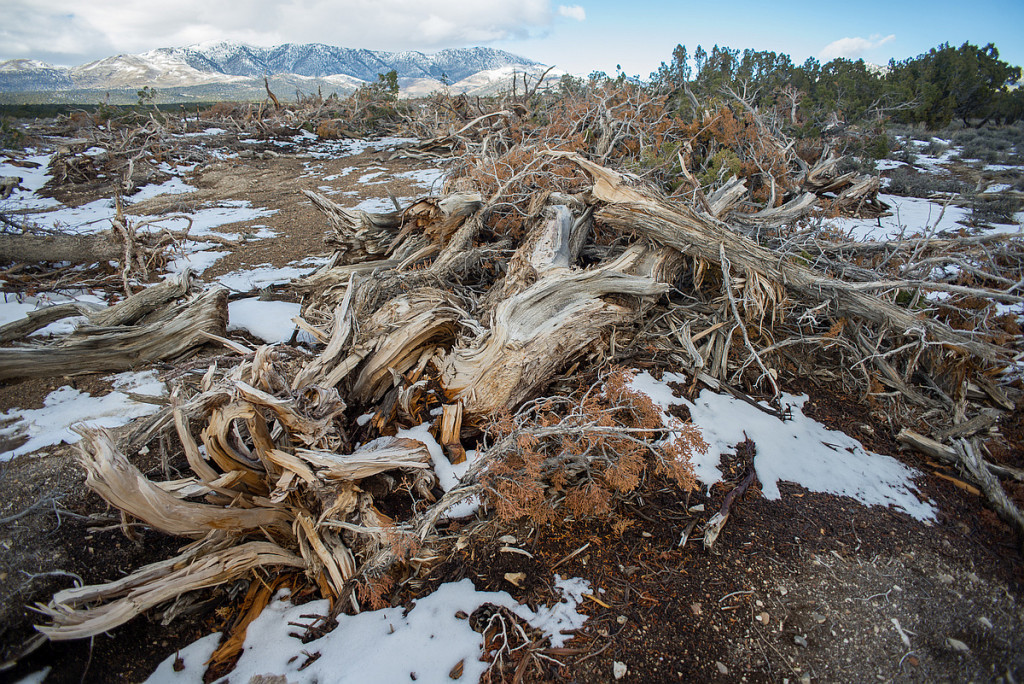
Old -growth Juniper and Piñon-Pine lie in a twisted heap in a chained area south of Spruce Mountain, Nevada. (Photo: © Max Wilbert 2015)
I can tell this particular clear-cut was “chained.” Chaining is a practice employed by the BLM and is done by stretching a U.S. Navy battle-ship anchor chain between two crawler tractors. The tractors are driven parallel to each other, dragging the chain across the forest floor, and uprooting everything in the chain’s path.
The area chosen for chaining has no logic, no reason behind it. The clear-cut follows no straight lines. The path the crawler tractors took follows no pre-conceived geometric plan. No one mapped out where trees would be cut and where they wouldn’t. The cut looks more like the devastating consequence of a petulant child’s temper tantrum than the cold-calculations of forestry professionals.
Moving through the middle of the clear-cut, now, the worst part is the silence. The silence is more than the absence of sound. This is a spiritual silence. The void seeps from the empty space where a forest once stood and flows into my consciousness. Where moments before I was surrounded in the sense of the presence of life, now there is nothing. Nothing, except the rotting corpses of a once thriving forest community.
I want to know how this is possible. I want to know what justifications cleared the way for this destruction. I want to know who is behind this. I want to know why.
***
The history of pinyon-juniper deforestation in the Great Basin as well as a list of justifications and motivations for deforestation is too long, perhaps, for one essay. The truth is, I am still learning. I have spent the last three weeks reading everything I can about pinyon-juniper forests and I wish to sketch a broad storyline. This storyline includes dominance of ranching and mining interests in Nevada, a governmental bureaucracy that consistently drinks the kool-aid prepared by ranchers and miners, the historical amnesia that characterizes settler colonialism, insidious racism, blatant genocide, and what pinyon-juniper expert Ronald Lanner calls “dendrophobia for which there seems to be no treatment.” Because one essay cannot possibly provide the whole story – a story pinyon-juniper forests desperately need to be told – I will broadly describe the major themes in this essay and I plan on writing a series on pinyon-juniper forests exploring specific themes in more detail.
The history of pinyon-juniper deforestation in the Great Basin is a glimpse into the dominant culture’s insanity. There was a truly sustainable way to live in the Great Basin, but the arrival of European settlers doomed that way of life. The Shoshones and Goshutes lived for thousands of years hunting game in the spring and summer and gathering pine-nuts in the fall. This sustainability involved understanding how to manage their populations so the land’s ability to support humans would not be drawn down. Ronald Lanner in his foundational work “The Pinyon Pine: A Natural and Cultural History,” credits pinyon pine-nuts as the essential food source that made it possible for humans to live in the Great Basin. Of course, the Great Basin’s original peoples have always known this, and know that destroying the forests is suicidal.
European settlers arrived in droves looking for precious metals and bringing their “white man’s buffalo” (domesticated cattle). Mines were established and the only reliable source of wood in most of Nevada was pinyon-juniper forests. Lanner explains, “The production of mineral riches would not have been possible in nineteenth century Nevada without the pinyon woodlands and their vast supplies of wood. The opening of a mine was only the first of many operations necessary to convert hard rock into treasure. Huge labor forces had to be brought in to work the mines and to build and operate stamp mills, smelters, amalgamators, and concentrators. Lumber in enormous quantities was needed for these operations: timbers for shoring the mine shafts, charcoal for smelting ore, cordwood for heating and cooking. The great Nevada silver boom ran on wood.”
Lanner goes on to quantify the destruction and the numbers are absolutely devastating. He explains the destruction around Eureka, Nevada in the 1870s: “A typical yield of pinyon pine was ten cords per acre, and a cord made about 30 bushels of charcoal. So the furnaces of Eureka, working at capacity, could in a single day devour over 530 cords of pinyon, the produce of over 50 acres. An additional 20 acres a day were being cut to provide cordwood for the mills. After one year of major activity, the hills around Eureka were bare for ten miles in every direction. By 1874, the wasteland extended twenty miles from town, and by 1878 the woodland was nowhere closer than fifty miles from Eureka.”
As is so often true, the destruction of the land is the destruction of the land’s original peoples. Lanner describes the situation in Nevada for the Shoshone as a “vicious circle” and writes, “The mining and urban activities there required huge amounts of wood and the burgeoning population consumed prodigious amounts of food. Local Indians helped provide both of these commodities by working for wages as lumberjacks and ranch hands. Those who cut down trees were destroying the source of their traditional winter food, pine nuts. Those who punched cattle aided and abetted the eradication of the native grasses that provided their traditional summer fare of grass seed. The more these food sources were destroyed, the more dependent the Indians became on wages; and the more they engaged in lumbering and ranching for white men, the more they destroyed their food sources. By the time the bubble burst in the 1880s and 1890s when the mining industry collapsed, the pinyon groves were gone, the valley grasslands were fenced for cattle, and much of the old culture was forsaken.”
The 1950s ushered in the next era of pinyon-juniper deforestation as ranchers became jealous of the presence of trees on potential grazing lands. Lanner notes that since the earliest white settlements in the Great Basin, accessible tracts of woodland had always been grazed. Lanner sums it up writing that overgrazing and timber trespass “combined to make the woodland one of the worst abused vegetation types in the West: even now the acre of woodland where one can find refuge from the ubiquitous cow pat is a rarity. But, as the post-World War II hunger for red meat mounted, the Forest Service started carving up National Forest woodlands with bulldozers and chains, hoping to create greener pastures.”
The ranchers’ jealousy of trees persists to today though new justifications for deforestation have been developed to thinly disguise the ranchers’ war on forests. A recent public scoping notice published on September 29, 2015 by the BLM, Carson City District, Sierra Front Field Office is illustrative.
It is not within the scope of this essay to address the problems with each of the BLM’s justifications. Many of the justifications require their own, full essay to thoroughly undermine them and I plan on writing those essays. Several of the reasons may be addressed, here, though. The BLM’s notice makes no attempt to hide ranching interests as a primary purpose for the treatments. This is clear as the BLM explains that one purpose of the vegetation treatment project is “to maintain and enhance rangeland health.” The problem with this is the Great Basin is not rangeland. The valley floors are naturally covered in sage brush and the highlands are pinyon-juniper forests. Converting the region into rangeland is only possible through great violence.
The BLM gives another justification for the deforestation with, “A large focus of this project would be to improve and protect greater sage-grouse habitat, and treatments would be designed to address threats to greater sage-grouse from invasive annual grasses, wildfires, and conifer expansion.” Of course, it was the BLM’s own disastrous policy of sage brush clearing that led to the sage grouse collapse in the first place. The BLM goes on to blame invasive annual grasses (most of which were brought to the Great Basin by settler activities), wildfires (exacerbated by human-created climate change, drought, and the planting of imported grasses that burn more quickly than native grasses), and finally to conifer expansion. By conifer expansion, the BLM is referring to pinyon-juniper forests who are simply regrowing in regions where they had been cut down by the mining operations of the 1870s.
***
I hope this essay serves as an introduction to the beauty of the Great Basin’s pinyon-juniper forests, the gifts they have long provided, and the dangers confronting them. It is time the BLM’s pinyon-juniper deforestation projects be stopped. The good news is a coalition of allied activists with Deep Green Resistance and WildLands Defense is in the early stages of planning a campaign to save these beautiful, essential, ancient forests. The first step is recognizing their inherent value as living beings. Stay-tuned for more updates including ways to get involved. Join us and stand on the side of pinyon-juniper forests.
Editor’s Note: The second installment of this multi-part series on pinyon-juniper deforestation can be found here.
Will Falk moved to the West Coast from Milwaukee, WI where he was a public defender. His first passion is poetry and his work is an effort to record the way the land is speaking. He feels the largest and most pressing issue confronting us today is the destruction of natural communities. He is currently living in Utah.
More information on this campaign can be found at Protect Piñon-Juniper Forests.





















